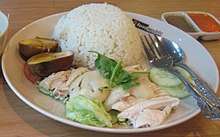Hainan people
|
Hainanese womenfolk in Hainan. | |
| Total population | |
|---|---|
| ~10 million worldwide | |
| Regions with significant populations | |
| Hainan, Southeast Asia (Vietnam, Cambodia, Thailand, Singapore, Malaysia and Indonesia), Oceania, Americas | |
| Languages | |
| Hainanese, Mandarin, Cantonese, Hlai languages, Kim Mun, Tsat, Danzhou dialect and various languages of the countries they inhabit | |
| Religion | |
| Chinese Buddhism, Chinese folk religion, Taoism, Christianity | |
| Related ethnic groups | |
| Hoklo people, Teochew people, other Han Chinese groups.[1] |
The Hainan people (Chinese: 海南人), also known as Hainanese or Hailam (in Hokkien dialect, especially in Malaysia and Indonesia), are a Han Chinese subgroup who originate from Hainan, the southernmost and smallest Chinese province. The term "Hainanese" was frequently used by Hainanese-speaking Han Chinese (Chinese: 海南漢人), who are the majority in the island, to identify themselves overseas. Nevertheless, other natives of the island such as Hlai (Chinese: 黎族), Yao (Chinese: 苗族 "Miao people") and Utsuls also use the term.
History
_(14784285493).jpg)
Most Hainanese Han people were originally fisherfolk[2] from the Fujian,[3] Guangdong[4] and Guangxi provinces who later settled in the island of Hainan, while the Li natives came to the island earlier and were descendants of the Yue tribe, from the mainland.[5] Many ancestors of the Southern Min Hainanese-speaking people came from Southern Fujian, while all of the ancestors of the Danzhou-speaking people came from Guangdong. As a result of the assimilation of other dialect groups, most Hainanese genetically cluster with Han Chinese from Guangdong and Guangxi instead of Fujianese people.[6]
Similarly to Fujian and Guangdong provinces, Hainan has been a source for immigrants. Towards the turn of the 20th century, many Hainanese migrated to various Southeast Asian nations, where they worked as cooks, restaurateurs, coffee shop owners, clothesmakers, sailors and hoteliers. Chan Sing, one of the "villain" movie stars that dotted the Hong Kong movie industry was of Hainanese ancestry, as was the bartender who invented the world-famous Singapore Sling at the renowned Singapore Raffles Hotel, Mr. Ngiam Tong Boon. In Thailand, singer Nichkhun of 2PM, media mogul Sondhi Limthongkul, the politically influential Sarasin family, as well as two of the wealthiest business families, the Chirathivats and the Yoovidhyas, all trace their ancestries to Hainan.
Culture
Language
In Hainan, the local Han Chinese speak Hainanese, a Min Chinese language also known as Qiongwen, as their native tongue. The dialect of Wenchang (文昌) is spoken by Hainanese from the northern parts of Hainan.[7] Ancestors of the Wenchang Hainanese were mostly merchants from Hokkien. This is also why they pronounce some words with the Hokkien twang (example: close door is "gieh mui" for other Hainanese dialects. Wenchang pronounce as "gueh mui', just like in Hokkien "gueh mng"). Today, many Wenchang Hainanese still return to Hokkien for ancestors tomb cleaning (清明). With Hainan's proximity to Guangdong and Guangxi, some locals can also understand and speak Cantonese. Standard Chinese (phonologically based on Beijing Mandarin) is also the lingua franca in the island province as in the rest of China.
Cuisine
The Hainanese are known for their signature dishes such as the Hainanese chicken rice, Wenchang chicken, Hainanese pork chop, Hainanese mutton soup, Hainanese salted fish soup and beef noodle soup.
Notably, in Singapore, these signature dishes are served at the various eateries located along Purvis Street, within the Hainanese enclave; as a result, Purvis Street is often referred to as "Hainan Second Street", while Middle Road and Seah Street are referred to as "Hainan First Street" and "Hainan Third Street" respectively.[8] Hainanese chicken rice is a recognised dish throughout Southeast Asia due to the Hainanese diaspora in these areas who famed it. It is often labelled as Singapore's national dish.[9]
Arts
Hainanese Opera (Qiong Opera) is a passion for many Hainanese, particularly for the older generation. Enriched with local flavours, Hainanese Opera is part and parcel of Hainanese culture.[10]
See also
References
- ↑ Li D, Li H, Ou C; et al. (2008). "Paternal genetic structure of Hainan aborigines isolated at the entrance to East Asia". PLoS ONE. 3: e2168. doi:10.1371/journal.pone.0002168. PMC 2374892. PMID 18478090.
- ↑ Tim Doling (1972). The Annals of Philippine Chinese Historical Association, Issues 3-7. Philippine Chinese Historical Association.
- ↑ Paul Hattaway (2004). Peoples of the Buddhist World: A Christian Prayer Diary. William Carey Library. ISBN 08-780-8361-8.
- ↑ Koen De Ridder (2001). "Weiying Gu". Authentic Chinese Christianity: Preludes to Its Development (nineteenth and Twentieth Centuries). Leuven University Press. ISBN 90-586-7102-X.
- ↑ David Goodman (2002). China's Provinces in Reform: Class, Community and Political Culture. Routledge. ISBN 11-347-1270-7.
- ↑ "A comprehensive map of genetic variation in the world's largest ethnic group - Han Chinese". bioRxiv 162982.
- ↑ "Archived copy". Archived from the original on 2011-06-05. Retrieved 2011-04-15.
- ↑ Abigail Ng WY (23 March 2017). "Youth camps keep Hainanese alive". The Straits Times Singapore. Retrieved 2017-05-23.
- ↑ Kugiya, Hugo (March 18, 2010). "Singapore's national dish: Hainan chicken rice". Crosscut. Archived from the original on 2011-08-31. Retrieved August 20, 2011.
- ↑ Tim Doling (1996). Visiting Arts regional profile: Asia Pacific arts directory. UNESCO Publishing. ISBN 92-310-3254-2.
| Wikimedia Commons has media related to Hainanese people. |
